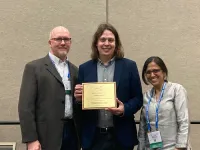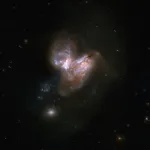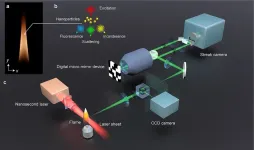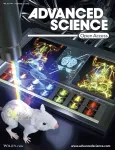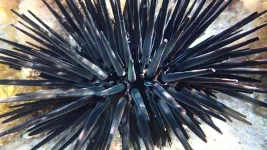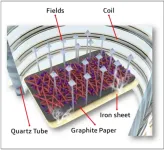(Press-News.org) More than 100 years ago, Charles Doolittle Walcott from the Smithsonian Institution was asked to examine strange star-shaped fossils with lobes hailing from the ~ 514-million-year-old Conasauga Formation in Alabama. Walcott described these odd fossils as jellyfish that likely floated in the middle Cambrian seas of what is now the southeastern United States. Little did he know that the Cambrian fossil he named would cause over 100 years of controversy.
The controversy hinged on the interpretation of what Brooksella really was: Was it truly a jellyfish that would be important for middle Cambrian marine ecosystems, a time when animals were originating and diversifying for the first time on Earth? Or was Brooksella just preserved gas bubbles? Or maybe it was a type of bulbous algae? Or a glass sponge made of opaline silica?
Or, as hypothesized, perhaps Brooksella was not a fossil at all.
Using shape and chemical analyses combined with high-resolution 3D imaging, we evaluated whether Brooksella was a fossil, like a sponge, a trace fossil, representing the burrows of worm-like animals, or not a fossil. We found that Brooksella lacked characteristics of glass sponges, specially, the opaline-fused spicules that compose the body. Nor did it grow as a sponge would be expected to over its lifetime. Importantly, in the field, its purported excurrent canal (osculum) was always oriented down in the sediment, which would make it very hard—if not impossible— to filter water for food. We also did not find any indication that worms made the iconic star- shaped lobes. We then compared the composition and internal structure of Brooksella to silica concretions from the same middle Cambrian rock beds. We did not find any difference between Brooksella and the concretions, other than Brooksella had lobes and the concretions did not. We thus concluded that Brooksella was not part of early sponge diversification in middle Cambrian seas, but rather, was an unusual type of silica concretion. Concretions can be all kinds of shapes to the point some look like they were organically formed.
The significance of our finding is two-fold: First, there are numerous enigmatic Cambrian fossils that need to be scrutinized to determine if they are really fossils to help paleontologists refine biodiversity estimates for the Cambrian when most of Earth’s major animal groups originated. Second, this is not the first time that unusual fossils and rocks from the Cambrian have puzzled scientists, and our findings highlight the necessity of close scrutiny of early fossil materials, especially using newer, powerful analytical techniques like micro-CT in combination with classic lab and field approaches.
Major Points:
Brooksella is an enigmatic star-shaped fossil from middle Cambrian rocks in Alabama with purported excellent 3D preservation In over 100 years since C. D. Walcott named it, Brooksella has been interpreted as a jellyfish, algae, gas bubbles, burrowing worms, and most recently, a sponge.
Morphological, structural, and chemical analyses did not support any of the previous interpretations for Brooksella, especially that of a glass sponge and worm burrows. Surprisingly, we found that Brooksella’s internal structure and composition was no different from co-occurring silica concretions, which we now claim it is. Our findings highlight the necessity of close scrutiny of early purported fossils especially with the powerful analytical techniques like micro-CT in combination with traditional field and lab approaches.
Quotes from authors:
Morrison Nolan, Department of Geosciences, Virginia Tech:
“Brooksella alternata interests me because so many scientists have worked on identifying it and have come to very different conclusions. It really illustrates how difficult it can be to distinguish one type of life from another, and even life from non-life, which is especially challenging for early materials in the geologic record.”
“Amateur paleontological/geological groups like the Georgia Mineral Society helped me learn about Brooksella and other interesting geological features around me. Such groups do a great job of teaching the public about the geologic past and bringing people to the field to see and learn about these features.”
Sally Walker, Professor of Paleontology at the University of Georgia in Athens, Georgia, USA:
“Brooksella intrigued me because, unlike most fossils, it had a 3D shape like a star-shaped puffed pastry that is unusual for soft-squishy animals like a sponge. A sponge usually gets flattened like roadkill during the fossilization process—especially a fossil more than 500 million years old! Also puzzling was the fact that no one inspected Brooksella where it lived and its orientation; if they did, they would find that most lobes were oriented downward, which does not make sense for a sponge to be eating mud. Lastly, the puzzle of Brooksella continues: What are the physical, chemical and perhaps biological processes that actually formed these strange Brooksella concretions? That is for a future paleontologist to solve!”
James Schiffbauer, Associate Professor of Geological Sciences, University of Missouri:
“While the applications for microCT have been nearly endless in the materials sciences and engineering fields, its capacities for elucidating the fossil record are really just beginning to be explored. This project is an excellent example of the types of fossil mysteries we can solve with applications of microCT. When we can scrutinize the internal construction of Brooksella with reference to its many past interpretations, it becomes increasingly apparent that none of them really match.”
END
Is the middle Cambrian Brooksella a hexactinellid sponge, trace fossil or pseudofossil?
2023-02-24
ELSE PRESS RELEASES FROM THIS DATE:
The Biophysical Journal names Carlas S. Smith the 2022 Paper of the Year-Early Career Investigator awardee
2023-02-24
ROCKVILLE, MD – Carlas S. Smith, PhD, of Delft University of Technology, the Netherlands was honored as the recipient of the Biophysical Journal Paper of the Year-Early Career Investigator Award at the 67th Annual Meeting of the Biophysical Society, held February 18-22 in San Diego, California. This award recognizes the work of outstanding early career investigators in biophysics. The winning paper is titled “Precision in Iterative Modulation Enhanced Single-Molecule Localization Microscopy.” The paper was published in ...
New discovery sheds light on very early supermassive black holes
2023-02-24
Astronomers from the University of Texas and the University of Arizona have discovered a rapidly growing black hole in one of the most extreme galaxies known in the very early Universe. The discovery of the galaxy and the black hole at its centre provides new clues on the formation of the very first supermassive black holes. The new work is published in Monthly Notices of the Royal Astronomical Society.
Using observations taken with the Atacama Large Millimeter Array (ALMA), a radio observatory sited in Chile, the team have determined that the galaxy, named COS-87259, containing this new supermassive ...
World’s fastest laser camera films combustion in real time
2023-02-24
By illuminating a sample surface with short laser beam pulses, it is possible to film sequences of various chemical and physical reactions. A research team that included researchers from the University of Gothenburg has now developed the world’s fastest single-shot laser camera, which is at least a thousand times faster than today’s most modern equipment for combustion diagnostics. The discovery has enormous significance for studying the lightning-fast combustion of hydrocarbons.
What happens ...
Exercise more effective than medicines to manage mental health
2023-02-24
University of South Australia researchers are calling for exercise to be a mainstay approach for managing depression as a new study shows that physical activity is 1.5 times more effective than counselling or the leading medications.
Published in the British Journal of Sports Medicine, the review is the most comprehensive to date, encompassing 97 reviews, 1039 trials and 128,119 participants. It shows that physical activity is extremely beneficial for improving symptoms of depression, anxiety, and distress.
Specifically, the review showed that exercise interventions ...
Faster and sharper whole-body imaging of small animals with deep learning
2023-02-24
It takes a few moments for the sound of thunder to reach our ears after a flash of lightning. This phenomenon is due to the photoacoustic (PA) effect where materials near the lightning instantly expand as the optical energy of the lightning is absorbed and converted into thermal energy. Using this PA effect, photoacoustic computed tomography (PACT) has become a premier preclinical and clinical imaging modality to take images inside the body without using a contrast medium. However, its low-quality images, which can be improved with multiple ultrasound sensors and a multi-channel data acquisition (DAQ) system, ...
Calming the destructive cells of ALS by two independent approaches
2023-02-24
· Diseased neurons have pathology in which proteins become misfolded and toxic
· Normally supportive cells attack the diseased neurons and destroy them
· This pathology occurs in 90% of ALS patient brains and in frontotemporal dementia and Alzheimer’s disease
CHICAGO --- Northwestern Medicine scientists have discovered two ways to preserve diseased upper motor neurons that would normally be destroyed in ALS, based on a study in mice. Upper motor neurons initiate movement, ...
Marine heatwaves decimate sea urchins, molluscs and more at Rottnest
2023-02-24
Curtin University researchers believe rising sea temperatures are to blame for the plummeting number of invertebrates such as molluscs and sea urchins at Rottnest Island off Western Australia, with some species having declined by up to 90 per cent between 2007 and 2021.
Lead author Adjunct Professor Fred Wells, from Curtin’s School of Molecular and Life Sciences, said the west end of Rottnest Island had suffered a “catastrophic decline” in biodiversity.
“Since 1982, we have monitored biodiversity of marine molluscs and echinoderms ...
Ultrafast synthesis of cobalt/carbon nanocomposites by magnetic induction heating for oxygen evolution reaction
2023-02-24
This study is led by Dr. Shaowei Chen (University of California). Natural gas reforming accounts for 95% of the hydrogen gas produced in the United States; yet the hydrogen is non-sustainable and “grey”, as it originates from fossil fuels . To obtain sustainable “green” hydrogen gas, electrochemical water splitting by using renewable electricity has emerged as one of the most promising technologies, which consists of hydrogen evolution reaction (HER) at the cathode and oxygen evolution reaction (OER) at the anode . Yet, due to the sluggish electron-transfer kinetics and complex reaction pathways, OER typically entails a large overpotential and severely ...
Building an ideal knowledge management system
2023-02-24
By Jovina Ang
SMU Office of Research & Tech Transfer – There are many reasons why knowledge management is important for an organisation.
Among the many reasons, the most mentioned are:
Speed up access to information and knowledge, or to people who hold the information you need;
Improve decision-making processes;
Promote innovation due to the sharing of ideas, collaboration and access to the latest information;
Improve the efficiency and productivity via reducing the tendency to “reinvent the wheel”;
Increase customer ...
KIST offers a novel paradigm for social robots
2023-02-24
After competing in the finals with the University College London, which presented Bubble Worlds, the research team led by Dr. Sona Kwak from the Korea Institute of Science and Technology (KIST; President Seok Jin Yoon) presented "CollaBot" and received the best award in the "hardware, design, and interface" category at the Robot Design Competition hosted by the International Conference on Social Robotics (ICSR) 2022, which was held at the Chamber of Commerce in Florence, Italy (December 13-16, 2022).
Previous studies on social robots were primarily based on humanoid robots that understand the context of situations and provide a range ...


